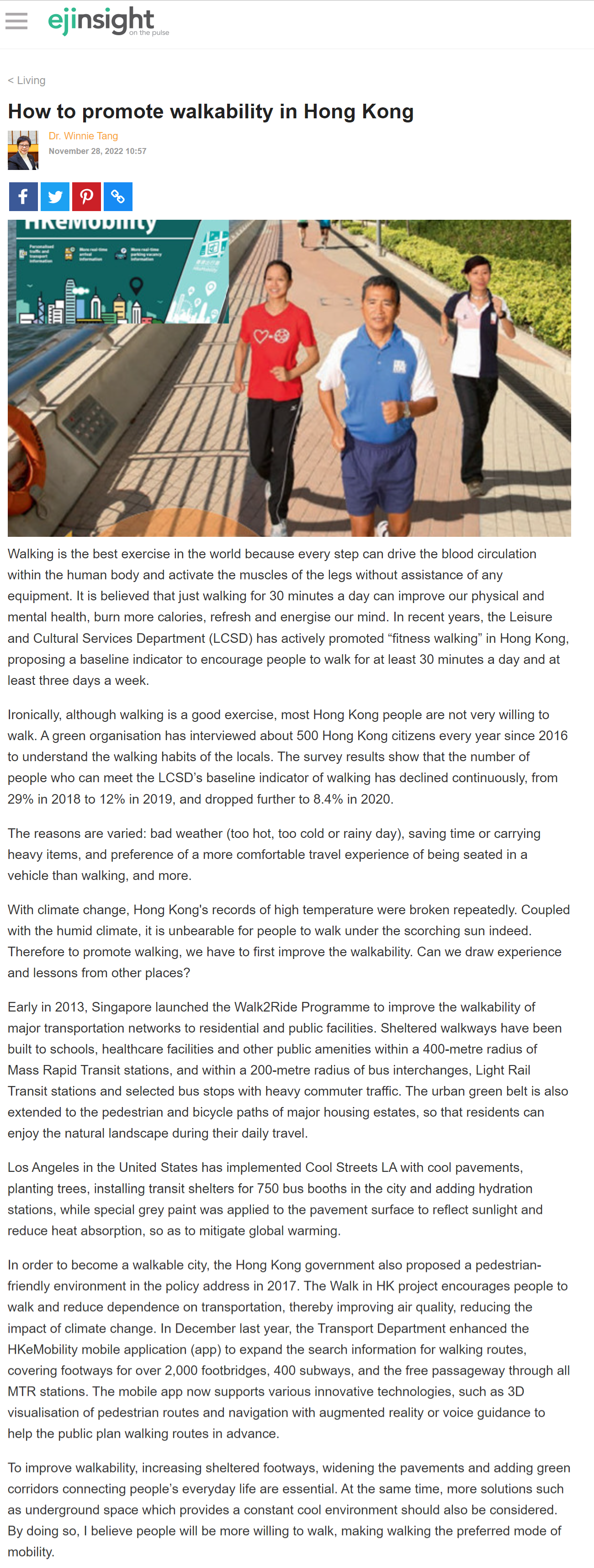網上版請按此

How to promote walkability in Hong Kong
Walking is the best exercise in the world because every step can drive the blood circulation within the human body and activate the muscles of the legs without assistance of any equipment. It is believed that just walking for 30 minutes a day can improve our physical and mental health, burn more calories, refresh and energise our mind. In recent years, the Leisure and Cultural Services Department (LCSD) has actively promoted "fitness walking" in Hong Kong, proposing a baseline indicator to encourage people to walk for at least 30 minutes a day and at least three days a week.
Ironically, although walking is a good exercise, most Hong Kong people are not very willing to walk. A green organisation has interviewed about 500 Hong Kong citizens every year since 2016 to understand the walking habits of the locals. The survey results show that the number of people who can meet the LCSD's baseline indicator of walking has declined continuously, from 29% in 2018 to 12% in 2019, and dropped further to 8.4% in 2020.
The reasons are varied: bad weather (too hot, too cold or rainy day), saving time or carrying heavy items, and preference of a more comfortable travel experience of being seated in a vehicle than walking, and more.
With climate change, Hong Kong's records of high temperature were broken repeatedly. Coupled with the humid climate, it is unbearable for people to walk under the scorching sun indeed. Therefore to promote walking, we have to first improve the walkability. Can we draw experience and lessons from other places?
Early in 2013, Singapore launched the Walk2Ride Programme to improve the walkability of major transportation networks to residential and public facilities. Sheltered walkways have been built to schools, healthcare facilities and other public amenities within a 400-metre radius of Mass Rapid Transit stations, and within a 200-metre radius of bus interchanges, Light Rail Transit stations and selected bus stops with heavy commuter traffic. The urban green belt is also extended to the pedestrian and bicycle paths of major housing estates, so that residents can enjoy the natural landscape during their daily travel.
Los Angeles in the United States has implemented Cool Streets LA with cool pavements, planting trees, installing transit shelters for 750 bus booths in the city and adding hydration stations, while special grey paint was applied to the pavement surface to reflect sunlight and reduce heat absorption, so as to mitigate global warming.
In order to become a walkable city, the Hong Kong government also proposed a pedestrian-friendly environment in the policy address in 2017. The Walk in HK project encourages people to walk and reduce dependence on transportation, thereby improving air quality, reducing the impact of climate change. In December last year, the Transport Department enhanced the HKeMobility mobile application (app) to expand the search information for walking routes, covering footways for over 2,000 footbridges, 400 subways, and the free passageway through all MTR stations. The mobile app now supports various innovative technologies, such as 3D visualisation of pedestrian routes and navigation with augmented reality or voice guidance to help the public plan walking routes in advance.
To improve walkability, increasing sheltered footways, widening the pavements and adding green corridors connecting people's everyday life are essential. At the same time, more solutions such as underground space which provides a constant cool environment should also be considered. By doing so, I believe people will be more willing to walk, making walking the preferred mode of mobility.
Dr. Winnie Tang
Adjunct Professor, Department of Computer Science, Faculty of Engineering; Department of Geography, Faculty of Social Sciences; and Faculty of Architecture, The University of Hong Kong